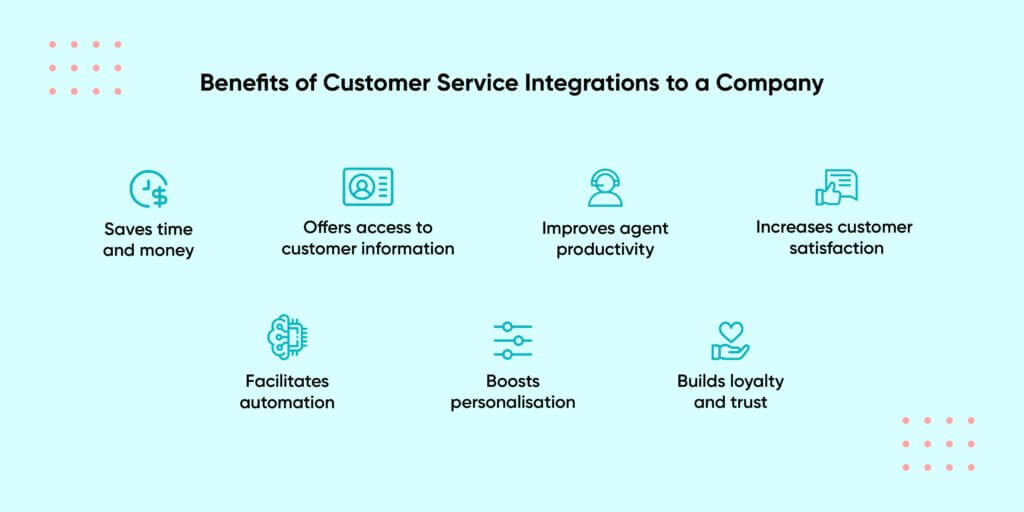5 Integrations to Improve Customer Service with Conversational AI
- June 17th, 2025 / 7 Mins read
-
Aarti Nair

5 Integrations to Improve Customer Service with Conversational AI
- June 17th, 2025 / 7 Mins read
-
Aarti Nair
Integration of conversational AI platform with the customer service tools allows businesses to attain economies of scale and better customer interactions. We look at how customer service integrations benefit your company and common tools you should integrate.
When a customer raises a query, the clock starts ticking.
45% of consumers expect their issue to be resolved in the very first interaction. But without context like order history, ticket status, or customer profile even the smartest AI agents can fall short.
That’s where integrations for customer service make the difference.
By connecting your conversational AI to essential tools for customer service like CRMs, helpdesks, payment systems, and more can help you enable fast, contextual responses that feel less like support, and more like service.
And it directly impacts business outcomes. 80% of customers now say the experience a company offers is as important as its products or services.
In this blog, we’ll explore 5 practical integrations that enhance your AI agent’s capabilities, like improving resolution times, cutting overhead, and delivering better experiences at scale.
In this article, we will cover:
- What is customer service integration?
- Why are customer service integrations important for businesses’ success?
- Why should you integrate your conversational AI platform with other tools?
- 5 prominent categories for customer service integration
- Customer service integration with conversational AI: the future of business
Let’s take a look. But first, let’s understand what are customer service tools.
What are Customer Service Tools?
Let’s start with the basics.
Customer service tools are platforms or software solutions that help businesses manage, track, and resolve customer queries—whether those come in through chat, email, phone, or social media. Think of tools like CRMs, ticketing systems, helpdesks, survey platforms, and knowledge bases. They’re built to streamline operations, keep teams aligned, and most importantly, make sure no customer slips through the cracks.
But why are these tools becoming increasingly central to how support teams operate?
Because customer expectations are growing—and fast. The global customer service software market was valued at USD 10.50 billion in 2022 and is projected to more than double by 2030, reaching USD 22.85 billion, growing at a CAGR of over 10%.
Clearly, businesses aren’t just investing in service but they’re investing in scale, speed, and consistency.
And when these tools are integrated with conversational AI, they don’t just support agents, they also empower them to deliver faster, more contextual, and seamless customer experiences.
What is customer service integration?
Ever wondered why some support teams feel effortlessly coordinated—while others are stuck juggling tabs, copying data, and chasing updates?
It often comes down to one thing that is integration.
Customer service integration is the process of connecting different tools, platforms, and systems used in your support workflow—so they talk to each other, automatically. Instead of jumping between your CRM, ticketing tool, chatbot dashboard, and feedback forms, integrations bring them all together in one connected environment.
Still not sure what that looks like in practice?
Let’s say a customer raises a query via your chatbot. With integrations in place:
-
The chatbot instantly fetches their order history from your CRM.
-
It logs a ticket in your helpdesk if escalation is needed.
-
It syncs that ticket status back to the chatbot, so the user stays updated in real-time.
No manual copy-pasting. No team silos. Just fast, efficient service powered by systems that actually collaborate.
So, if your support stack feels more like a patchwork of tools than a unified experience—integrations might be the missing piece.
The most common categories under customer service integrations include CRMs, ticketing platforms, payment channels, marketing platforms, messaging channels, etc.
One must understand the importance of customer service integrations before adopting the tools to do so. Though there are multiple tools available, we must compare and contrast them to get a result that works both for the business and the customer.
Why are customer service integrations important for success?

Customer interactions are changing these days. With the rapid digitisation of communication, messaging channels are increasingly being adopted. Studies show that chatbots can handle more than 58% of customer tickets, achieving a success rate of 87%
But these aren’t your regular flow-based chatbots that we are talking about. Your business will see this result if you are using a conversational AI chatbot that is integrated with your tools to provide a seamless and personalised experience.
“Just having satisfied customers isn’t good enough anymore. If you really want a booming business, you have to create Raving Fans.” – Ken Blanchard
The integrations depend on what your customers are asking for in their journey. To ensure a positive experience, companies need to pay attention to their demands. As Salesforce research suggests, 89% of consumers are more likely to make another purchase after a positive customer service experience.
If you are looking for more reasons to give customers what they want, Forbes’s research showed that improving customer retention rates by just 5% can increase profits by between 25–95%.
The crucial reasons why customer service integration decides the success of a business are:
- Saves time and money by reducing manual work
- Facilitates automation of repetitive tasks
- Offers the opportunity to access information seamlessly, for example, during a live chat
- Boosts personalised messages by customising information
- Improves overall productivity by reducing to-and-fro from one platform to another
- Increases customer satisfaction by providing quick and personalised information
- Builds the loyalty of customers and employees
Suggested Reading: Faster, Smarter, Better — AI is Improving Customer Service
Why should you integrate your conversational AI platform with other tools?
A
Think of your conversational AI platform as a powerful engine. On its own, it’s capable of handling a lot — answering queries, automating responses, collecting data. But what happens when you plug it into the rest of your tech stack?
That’s when things really take off.
Integrating your conversational AI with other customer service tools — like your CRM, helpdesk software, ticketing system, or analytics platform — allows you to connect the dots across the customer journey. Rather than working in silos, your systems can now share data in real time. The result? Smarter, faster, more personalised support.
Here’s what that looks like in practice:
1. Contextual Conversations
When your chatbot pulls customer history from the CRM, it doesn’t need to ask for basic information like name, account number, or past interactions. This reduces friction and makes the conversation feel more natural and human.
Imagine a customer who’s already raised a complaint. Instead of saying “How can I help you today?”, your bot can say, “I see you reached out about a refund yesterday. Would you like an update on that?”
2. Faster Resolutions
Integrations with ticketing tools like Zendesk or Freshdesk mean your bot can raise, update, and close tickets without human intervention. That’s fewer delays, fewer transfers — and more first-contact resolutions.
3. Better Handoffs to Agents
When escalation is needed, your AI platform can pass along full conversation history, user profile, and sentiment analysis to the human agent. No more asking the customer to repeat themselves. The agent picks up right where the bot left off.
4. Proactive Support
By integrating with payment systems or order tracking platforms, your bot can reach out with delivery updates, payment reminders, or outage alerts — before the customer even asks. This builds trust and reduces inbound query volume.
5. Insightful Analytics
When data from all tools flows into one dashboard, your customer service leaders can track KPIs more accurately. You can spot bottlenecks, measure resolution speed, identify trending issues, and continuously optimise the experience.
So, why integrate?
Because customers don’t see “tools” — they see one brand. Integrations help your systems work together, so your customers don’t have to repeat themselves or wait longer than necessary.
It’s not just about efficiency. It’s about delivering a support experience that feels seamless, intelligent, and genuinely helpful.
5 prominent categories for customer service integration
Statista reported that 34% of retail customers feel comfortable chatting with customer service through an AI chatbot, rather than live chat. To build an efficient customer service integration strategy with conversational AI, one can adopt any of the following tools for visible results:
1. Customer Relationship Management (CRM) System and Ticketing Platforms
One of the finest and most important customer service integrations is the CRM tool. A chief aim of businesses is to build and manage customer relationships, for which the CRM tool is crucial.
Keeping a record of customer interactions, their current dealings, and queries can help the business to offer customers the most appropriate solutions. A one-stop solution to track all generated leads, CRM systems help businesses grow.
Some examples of CRMs and ticketing platforms are Salesforce, HubSpot, Freshdesk, Zendesk etc.
By integrating with your CRM and ticketing platform, you can pull in relevant information about the customer and personalise the communication. It also empowers agents by giving them a unified view of the customer, reducing their time to toggle between tools.
Another advantage of integrating your conversational AI platform with your CRM is that new customer data gets automatically synced. This eliminated the post conversation time agents used to spend.
2. Marketing management system
Marketing management systems are specialised tools for each marketing discipline, such as demand generation, email marketing, marketing automation and analytics.
When integrated with chatbots or conversational AI, it helps get direct feedback from the customer and optimise the marketing strategies required for improved reach.
Examples of marketing management tools include Clevertap, Capillary, WebEngage, ipdata etc.
For the marketing function, this integration helps gather more customer information. It gives them more visibility into customer behaviour. The more you understand the customer the better strategy and data-driven targeting/segmenting you can create. This way, you can maximise your ROI and get started with conversational marketing.
3. Payment channels
An integrated payment channel helps optimise and streamline business processes involved in making payments. They can be tailored to the business and customers they serve.
As a modern mode of payment, integration of your payment gateway with your conversational AI platform offers a robust payment experience during the point of sale.
Razorpay, CCAvenue, Xendit, PayPal, Faspay, Cash U are some examples of payment gateways.
The benefits of integrating your payment platform with your conversational AI platform is that speeds up the process provide customers with completing their payments without changing the communication channel (like WhatsApp) and personalises their experiences. This improves customer satisfaction.
Suggested Reading: Level-up CX by Integrating Payment Gateways with Chatbots
4. Messaging channels
Customers are looking for an omnichannel experience. They want to communicate with businesses on different messaging platforms. And there are many benefits of being available for your customers where they are.
You see higher engagement, interactive communication, faster response and resolution of issues, among other things.
Messaging channels could be anything from instant messaging platforms such as WhatsApp and Viber to social media channels such as Facebook and Instagram.
Integrating your customer service conversational AI platform with your messaging channels help you get closer to your customers and expand your reach.
Not only are the customers happy, but the agents are also happy with this integration too. They don’t have to log in to different platforms to respond to customers. For them, they get a unified customer query view with the benefits of conversational AI. A win-win situation for your business.
5. Others
There are many other integrations that you could benefit from. If your conversational AI platform doesn’t provide analytics and a dashboard, you can integrate with a tool that does and track the performance.
A product analytics system analyses user interaction with products to focus on features that deliver the most engaging and useful experience.
Integration with employees’ engagement system collects feedback to determine job satisfaction, employee engagement and motivation. This customer service integration help to train better, facilitating employee growth.
These tools can also depend on your industry and requirements. Some examples include Shopify, Magento, Clearbit, Core Banking Solutions (e.g. Finacle), Google Maps, etc.
Customer service integration with conversational AI: the future of business
As businesses move ahead in the competitive environment by focusing on various integrations and development, the use of customer service tools with AI has increased exponentially. Offering meaningful insights about multiple areas and helping the business respond effectively have improved profitability.
SalesForce has reported that 66% of companies see increased tickets and service requests from digital channels. At the same time, chatbots are projected to save $0.70 per customer interaction, suggests CNBC.
To improve the overall customer service integration, it is important to implement successful and seamless conversational AI. Customer service integration using conversational AI and digital tools to manage the business and customers effectively will drastically improve the customer experience.

FAQs
1. What are customer service integrations?
Customer service integrations connect your conversational AI platform with other tools for customer service — like CRM, ticketing systems, and order management platforms — allowing data to flow seamlessly across systems for better context, faster resolution, and smarter automation.
2. How do integrations improve customer service performance?
Integrations reduce repetitive queries, eliminate data silos, and automate ticket handling. This helps agents respond faster and enables chatbots to resolve more issues without human intervention, improving first-contact resolution and customer satisfaction.
3. Which tools should I integrate with my conversational AI?
It depends on your workflow, but common integrations include CRMs (like Salesforce or HubSpot), helpdesks (like Zendesk or Freshdesk), payment gateways, inventory management systems, and analytics platforms.
4. Can I integrate conversational AI into legacy systems?
Yes. Many conversational AI platforms, like Verloop.io, offer APIs and pre-built connectors that allow integration with both modern and legacy systems. This ensures your support processes are future-ready without overhauling existing infrastructure.
5. Is it difficult to set up integrations for customer service platforms?
Not necessarily. Most leading AI platforms provide plug-and-play integrations or no-code workflows. However, for complex systems, your tech team or customer success manager from your AI provider can support you through the implementation.







